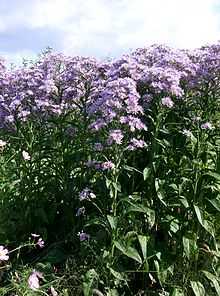Aster tataricus
| Aster tataricus | |
|---|---|
 | |
| Scientific classification | |
| Kingdom: | Plantae |
| (unranked): | Angiosperms |
| (unranked): | Eudicots |
| (unranked): | Asterids |
| Order: | Asterales |
| Family: | Asteraceae |
| Tribe: | Astereae |
| Genus: | Aster |
| Species: | A. tataricus |
| Binomial name | |
| Aster tataricus L. f.[1] | |
Aster tataricus is a member of the Aster genus of flowering plants.
Traditional uses
It is one of the 50 fundamental herbs of Traditional Chinese medicine, where it has the name zǐwǎn (Chinese: 紫菀). It has an antibacterial action, inhibiting the growth of Staphylococcus aureus, E. coli, Bacillus dysenteriae, B. typhi, Pseudomonas and Vibrio proteus.[2]
Traditional significance
In Japan, Aster tataricus is known as shion, or 紫苑. The flower has a meaning in Japanese language of flowers, which corresponds to "I won't forget you."[3]
See also
References
- ↑ "Aster tataricus information from NPGS/GRIN". Retrieved 2008-02-05.
- ↑ "Aster tataricus - Plants For A Future database report". Retrieved 2008-02-05.
- ↑ "Aster tataricus (Shion) - 紫苑 (シオン)". Retrieved 2011-09-18.